Making a Difference
A few months ago, one of our donors sent me an email asking an intriguing and much appreciated question—”What is the Sacred Land Film Project’s strategy for making a difference?” After a good deal of thought, I’m sharing my answer, which starts with a brief outline of our strategy:
1) Collaborative storytelling featuring the voices of indigenous people who offer an alternative value system as they struggle to protect sacred cultural landscapes.
2) An educational campaign using film, photography, written journalism, audio podcasts, websites, memoir and research publications to distribute these stories widely.
3) In three words we aspire to: Connect. Amplify. Change.
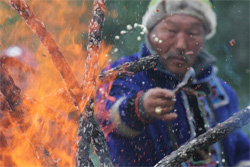
Altai Fire Ceremony
Like the poet Robinson Jeffers, my art is a product of grief. And my grief is rooted in love.
My strategy for making a difference is to tell creative, disruptive stories.
The Sacred Land Film Project’s goals are change of consciousness and improved public policy.
Having listened to indigenous elders, I’ve long believed in the urgent need for a change of cultural values in industrial society. From individual rights to community responsibility. From extraction and greed to generosity and sharing. Along with value change—and perhaps the factor that is most needed to encourage this change—native people have pointed out to me that disconnection from nature and blindness to the spiritual dimension of nature are at the heart of our environmental crisis.
We use films to seek improved public policy, by inspiring viewers to demand change. With each of our major documentaries we have reached multiple audiences: Congress, public television viewers, students of all ages, and communities. Whenever possible, indigenous leaders hold the microphone, lead discussions and answer questions.
The stories we tell focus on conflicts over sacred land. Our goal? To generate new perspectives, to change the lens, to shift the focus, to create a new filter other than the one imposed by corporate media. It was lonely work from 1978 through the broadcast of In the Light of Reverence in 2001. Things have shifted noticeably since then.
In 2012, at a meeting with sacred site guardians in South Korea, as we strategized to define our movement and our place in American and world history, Ken Wilson, then executive director of The Christensen Fund, described our challenge in five words, which I sketched in my notebook: genocide > invisibility > recognition > respect > protection
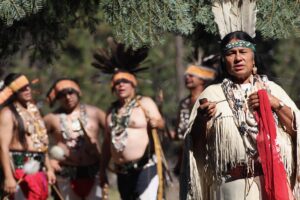
Winnemem Wintu in California
When I entered the scene in the late 1970s, I was motivated by the invisibility suffered by Native Americans. We were still very close to genocide (and perhaps still are). By 2012, thirty years into the work, as we distributed In the Light of Reverence and worked to complete Standing on Sacred Ground, Ken Wilson observed that collaborations between indigenous communities and allies had overcome invisibility and finally achieved recognition for sacred cultural landscapes. “Now we need to build respect and gain protection,” he said. It was too early to envision Land Back, but we were making progress! Collaborative storytelling was key to this success.
In 2016, I read an article titled “The Role of Narrative Change in Influencing Policy,” by Brett Davidson, which captured our strategy for making a difference using documentary film as an effective tool to bring about a value shift and policy change. As I read the article, I realized that through four decades of public education, the Sacred Land Film Project had developed some fundamental practices, discovered simply by doing the work through disruptive narratives.
Davidson argued: Reality is socially constructed, not rational. People make decisions and form their view of reality based on feelings. Social beliefs and behavior are shaped by narrative. Story matters. To make a difference, a series of steps are required for effective narrative storytelling to result in major social and policy change, usually over the long term:
- An issue has to become more salient, relevant and visible, as new information generates public concern and media attention, and then
- The issue is defined differently through a mix of empirical information and emotional appeal that alter peoples’ understanding of core values and exposes public policy as inadequate, and finally
- New actors begin to enter the arena, new voices, new energy, new storytellers, with a growing audience interested in hearing the stories, the alternative values, and the new perspective.
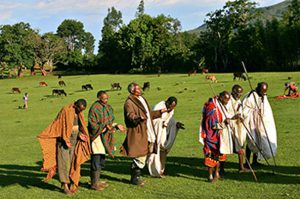
Ethiopia’s Gamo Highlands
Since 1978 the Sacred Land Film Project has amplified alternative values and “new” (actually old) perspectives. We are committed to long-term work. We employ art, journalism and creative activism, personal storytelling, and skillful use of a metaphor that is also a grounded, ancient reality: “sacred land.”
My 40-year path has been documenting ecocide while seeking beauty and justice.
When I joined the new Earth Island Institute and started the film project in 1984 native people were essentially invisible, wholly absent from Americans’ perceived “reality,” hence all manner of continuing insult. Ecosystem destruction and sacred site desecration in Hopi and Diné territory were the stories that grabbed me, evoked my passion, and enabled me to persist and navigate the demands of filmmaking, the stress of fundraising, and the challenges of collaborating with traumatized communities that were justifiably mistrustful of outsiders and media exposure.
Personally, the images of destruction we were gathering brought on deep grief, and I felt it in the audiences who watched our films and absorbed our stories. At screenings, we always encourage action, change of lifestyle, specific ways to support public policy change, and healing. It has been a continuous search for justice and fairness.
We believe the desired paradigm shift comes from imagination—hearing about alternative values, seeing successful models, feeling grief and love. We assert the values of the indigenous rights movement, tell success stories, show resilience in the face of adversity, demonstrate thriving biodiversity where sacred natural sites are protected, and enable the voices of indigenous wisdom keepers to inspire viewers, listeners and readers.
Over the years, we created and built a small community of people who care about sacred land and indigenous rights. We identified and nurtured this network of supporters and allies, educating them, bringing them into this struggle, raising money to help us make the films. Those are the sympathetic souls who also take political action necessary to press for change.
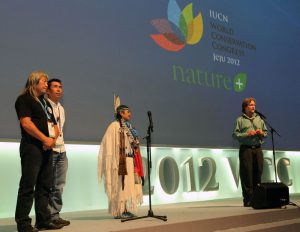
World Conservation Congress 2012 in Jeju, South Korea
Meanwhile, we focused on networking indigenous leaders and sacred site guardians from around the world, bringing them together for ceremony and gatherings such as IUCN’s World Conservation Congress (2008, 2012, 2016, 2021) and World Parks Congress (2003, 2014). We have shown films and organized panel discussions at each of these gatherings. A key aspect in this realm was my co-authoring IUCN’s Best Practice Guidelines for Protected Area Managers (2008), which placed the term “sacred natural sites” firmly in the international policy lexicon.
Raising “big budgets” for filmmaking, connecting with like-minded donors—large and small—turned out to be a skill that came naturally to me, using my education and privilege to get out into the field to document these stories. The editing challenge with each film is the knowledge that “to change reality through narrative,” every story has to “ring true” and have emotional power. Every scene has to feel authentic, every edit, every piece of music. We cannot afford to lose the audience for a moment. Integrity and skill are crucial and our strategy to “make a difference” has always rested on the importance of integrity—doing what we say we are going to do, getting our facts right, avoiding harmful controversy, accounting for every dollar, showing results, touching peoples’ hearts, reaching audiences. The fact that PBS broadcast all of our major documentaries has been the good housekeeping seal of approval. Getting the films into schools and libraries was always a primary goal, and In the Light of Reverence is now in 1,000 schools and libraries. That film is still used every semester in Native American Studies classes all over the United States, 22 years after the film was released. It has legs.
Ours is a cultural strategy, based on creative activism, using artistic filmmaking skill, symbol and story, to have emotional impact, draw attention to injustice, bring alternative voices to light, as we provide tools for grassroots groups, teachers and students to influence policy debates and literally change popular culture. Teachers’ guides, annual reports, our Sacred Land History Timeline, and websites all further the strategy.
Our approach seeks to facilitate storytelling as a way of opening up political space, destabilizing entrenched power relationships, and giving voice to voices that are usually drowned out, suppressed or simply ignored. In hindsight, I see now that our goal was to “change the narrative” about a stigmatized group. We wanted to open a space to a new view of history, where settler colonialism, white supremacy and New Age appropriation would look and feel different, embarrassing, “wrong.” All along we pursued the delicate balancing act of encouraging spiritual reconnection to the natural world, while discouraging appropriation of native cultural practices.
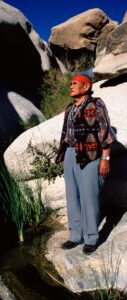
Thomas Banyacya visits Avi Kwa Ame in 1996
The killing of Michael Brown in 2014, water protector resistance at Standing Rock in 2016, and the murder of George Floyd in 2020, sparked a social justice reckoning that is long overdue.
After four decades of making films to tells stories of the spiritual dimension of nature and culture, this year we witnessed the president of the United States acknowledge the area around Avi Kwa Ame (Spirit Mountain) in Nevada as a sacred cultural landscape. The Biden administration has now established three national monuments in collaboration with indigenous nations in the Southwest, and the government has identified all of them as “sacred land.” This is historic—and an affirmation of our focused educational campaign. Creating the new monument this year in southern Nevada, Biden proclaimed Avi Kwa Ame “and the surrounding arid valleys and mountain ranges are among the most sacred places for the Mojave, Chemehuevi, Southern Paiute…” Hopi, and ten other tribes.
Similarly, Biden’s restoration of Bears Ears National Monument in southern Utah in 2021 (after Trump eviscerated it) declared, “Bears Ears is sacred land of spiritual significance, a historic homeland, and a place of belonging for indigenous people from the Southwest. Bears Ears is a living, breathing landscape…”
We view our work as a long-term commitment, aimed at shaping how people think about and understand specific issues and groups of people over time. It is work that takes place in contested terrain. It is human rights work, and environmental policy work, which, if successful, has potentially huge impact in transforming the social and cultural context within which much advocacy and social justice work takes place. Narrative can change values and public policy.
The Specifics of our Work
Ongoing educational film distribution of The Four Corners: A National Sacrifice Area? (1983), NOVA: Poison in the Rockies (1990), In the Light of Reverence (2001), Standing on Sacred Ground (2014) via Bullfrog Films.
All of our films are streaming on websites, Amazon Prime and Vimeo, and some are still being broadcast by PBS.
We have created a new Audio Archive to contribute to the long-form podcast space, utilizing the important interviews we have done over the years to further amplify the voices we’ve recorded. The two-hour interviews that yielded four minutes in our films have sat for years in a cabinet in our editing room. Now you can listen to lengthy interviews with Vine Deloria, Jr., Oren Lyons, Winona LaDuke, Davianna McGregor, Barry Lopez, with more on the way.
We have produced 50 “short films” on YouTube (analytics below), including 15 films on the West Berkeley Shellmound battle over the last seven years.
We continue to add Sacred Site Reports to the 125 in-depth reports on our website, to show global diversity, depth of threats, lessons learned, and actions readers can take to help each place and the community working to protect it.
I am writing a memoir to go deeper and use material that didn’t make it into films, to reach new audiences, and in turn bring more people to the films and the issues.
For me, this journey has been as much about learning to be a good ally as it has been about becoming an effective storyteller.
After 30 years of working with the Winnemem Wintu Tribe and more than ten years with the Ohlone, I recently evolved from a cultural bridge into a behind-the-scenes strategist, communications coordinator, and liaison between two indigenous women leaders and reporters, politicians, scientists and funders. On the agenda is Land Back at both the West Berkeley Shellmound and in Winnemem traditional territory below Mt. Shasta. I started doing what our films were meant to inspire people to do, working directly on restoration of endangered winter run Chinook salmon to the McCloud River, return of wild salmon from New Zealand, and return of ancestral remains from U.C. Berkeley to a protected West Berkeley Shellmound site.
Acting locally to support indigenous leadership inspires others and has been personally healing, helping me overcome grief and find joy through collaboration that seeks environmental justice through a spiritually-grounded process. I have enjoyed not being “the director” for the last few years.
Covid forced a filmmaking hiatus, but now I am stepping back from the role of activist and returning to filmmaking. We are producing a full-length documentary, highlighting the leadership of two indigenous women whose voices and vision are both timely and powerful—Ohlone leader Corrina Gould at the West Berkeley Shellmound and Winnemem Chief Caleen Sisk on the McCloud River.
To further answer the question “What is the Sacred Land Film Project’s strategy for making a difference?” here is a graphic that depicts our core identity, reputational aspiration and strategy in three words: Connect. Amplify. Change.
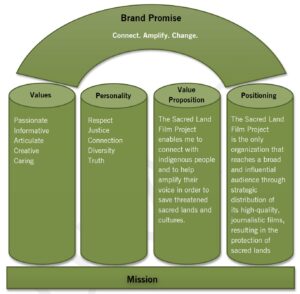
The Sacred Land Film Project’s mission is to use film, journalism and education to rekindle reverence for land, increase respect for cultural diversity, stimulate dialogue about connections between nature and culture, and help protect sacred lands and diverse spiritual practices.
For a sense of metrics in terms of the value and impact of our short films on YouTube:
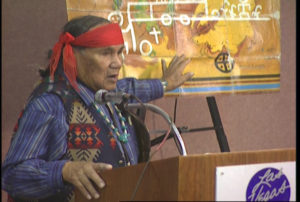
Hopi Elder Thomas Banyacya
Short Film Views—December 2023. (Our “Sacred Land Film” YouTube Channel has 16,100 subscribers.)
420,000 – Hopi Messenger—Thomas Banyacya (1,517 comments)
107,000 – Oren Lyons “We are part of the earth.” (170 comments)
69,000 – Indigenous Reflections on Christianity (937 comments)
149,000 – Thomas Banyacya on Hopi Prophecy – part 1 (571 comments)
58,000 – Thomas Banyacya on Hopi Prophecy – part 2 (225 comments)
41,000 – Vine Deloria, Jr. on Our Relationship to the Unseen (31 comments)
7,200 – My Ancestors’ Home—with Corrina Gould (266 comments)
Finally, I would like to thank the donor who asked this provocative and challenging question, and all project supporters who’ve read my reply to the end. I hope the answer was worth the wait.
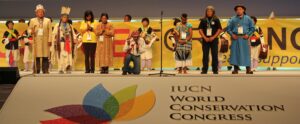
Sacred Site Guardians’ Prayer Ceremony in Jeju, South Korea in 2012
Blog Post Categories: Blog, North America, SLFP News, Success Stories